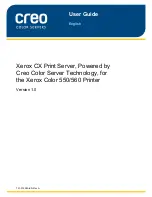
Chapter 2
2-15
- Print Bias (positive DC bias)
While printing sequence is under way, the machine uses the print bias to transfer the toner from the surface of the photosensitive drum to print paper.
- Sheet-to-Sheet Bias (positive DC bias)
While continuous printing is under way, the machine uses the sheet-to-sheet bias to make sure that the residual toner on the photosensitive drum will not move
to the surface of the ETB.
- Cleaning Bias (negative DC bias)
The machine uses the cleaning bias to move the toner sticking to the ITB back to the photosensitive drum.
The level of the transfer bias varies according to the instructions from the DC controller PCB.
The DC controller PCB adjusts the output of the transfer bias according to the transfer current feedback signal (TRS) from the transfer bias generation circuit to
maintain a specific level of transfer efficiency (constant current control).
2.4.2.6 Generation of the Fixing Bias
0010-6085
LBP5000 / LBP5100
The machine uses the fixing bias (FSR) to prevent the movement of toner from the print paper to the fixing film before fixing.
The fixing bias may be a positive DC bias or a negative DC bias generated by the fixing high-voltage generation circuit of the high-voltage power supply PCB. The
machine applies the fixing bias to the fixing pressure roller at specific timing.
2.4.2.7 Electrostatic eliminate bias
0015-7917
LBP5100
The electrostatic eliminate bias is added for decreasing an electrical potential on paper surface, which became too high due to the transfer bias.
This bias is the DC positive bias generated in the electrostatic eliminate high-voltage generation circuit in the high-voltage power supply PCB. It is applied to the
electrostatic eliminator unit just for the period where the leading edge of paper separates from the ETB until the delivery operation is completed.
2.4.2.8 ETB drive roller bias
0015-7918
LBP5100
The ETB drive bias is added for toner holding enhancement onto force of paper which electrical potential is decreased due to the electrostatic eliminator unit.
This bias is the DC positive bias generated in the sub high-voltage power supply PCB. It is applied to the ETB drive roller just for the period where the leading edge
of paper separates from the ETB until the trailing edge of paper passes through the fixing unit.
2.4.3 Image Stabilizaton Control
2.4.3.1 Overview of the Image Stabilization Control Mechanism
0010-6074
LBP5000 / LBP5100
The machine uses its image stabilization control mechanism to prevent lowering of image quality (e.g., in the form of a faulty image) otherwise caused by changes
in the environment or deterioration of the photosensitive drum or toner.
The machine's image stabilization control mechanism may be any of 4 types: Environment corrective control, Image density corrective control (D-max control),
Image halftone corrective control (D-half control), Color Misregistration Corrective Control.
T-2-2
2.4.3.2 Environment corrective control
0010-6075
LBP5000 / LBP5100
The DC controller checks the site environment with reference to the temperature/humidity information from the environment sensor (SR12), and controls the var-
ious high-voltage biases so as to ensure the production of optimum images.
The machine executes environment control at the following timing:
- when the power is turned on
- when a cartridge has been replaced
- when there has been an appreciable change in the environment
2.4.3.3 Image density corrective control (D-max control)
0010-6076
LBP5000 / LBP5100
The machine executes image density correction to stabilize the image density by controlling the printer engine.
When a specific condition exists, the DC controller executes D-max control in the following sequence:
1. It measures the density patterns of individual colors drawn on the ETB.
2. It controls the primary charging bias and the developing bias based on the measurements of the individual patterns to ensure optimum density.
The conditions used to execute the mechanism are the following:
- when the power is turned on.
- when a cartridge has been replaced.
- when an appreciable change has occurred in the environment.
- A specific period of time after the end of printing
- when the user requests the execution of calibration.
Condition
Control item
Remarks
Environment
corrective
control
D-max control
D-half control
Color
Misregistration
Corrective
Control
When the power is turned on
Yes
Yes
Yes
Yes
When a cartridge has been replaced
Yes
Yes
Yes
Yes
When a specific number of prints have been
made
Yes
Yes
Yes
When an appreciable change has occurred in
the environment
Yes
Yes
Yes
A specific period of time after the end of
printing
Yes
Yes
Yes
Executed as set by the user; however, not
enabled in a sleep state.
(OFF by default)
When the user requests calibration
Yes
Yes
Yes
Summary of Contents for LBP5000 Series
Page 1: ...Feb 26 2007 Service Manual LBP5000 5100 Series...
Page 2: ......
Page 6: ......
Page 14: ...Contents...
Page 15: ...Chapter 1 PRODUCT DESCRIPTION...
Page 16: ......
Page 18: ......
Page 28: ......
Page 29: ...Chapter 2 TECHNICAL REFERENCE...
Page 30: ......
Page 33: ...Contents 2 8 3 2 Overview of the Block 2 39...
Page 34: ......
Page 74: ...Chapter 2 2 40 IC12 Logic IC Converts voltage levels Notation Name Description...
Page 75: ...Chapter 3 DISASSEMBLY AND ASSEMBLY...
Page 76: ......
Page 80: ......
Page 122: ......
Page 123: ...Chapter 4 MAINTENANCE AND INSPECTION...
Page 124: ......
Page 126: ......
Page 132: ......
Page 133: ...Chapter 5 TROUBLESHOOTING...
Page 134: ......
Page 136: ......
Page 141: ...Chapter 5 5 5 F 5 9...
Page 142: ...Chapter 5 5 6 F 5 10...
Page 149: ...Chapter 6 APPENDIX...
Page 150: ......
Page 152: ......
Page 161: ...Feb 26 2007...
Page 162: ......
















































